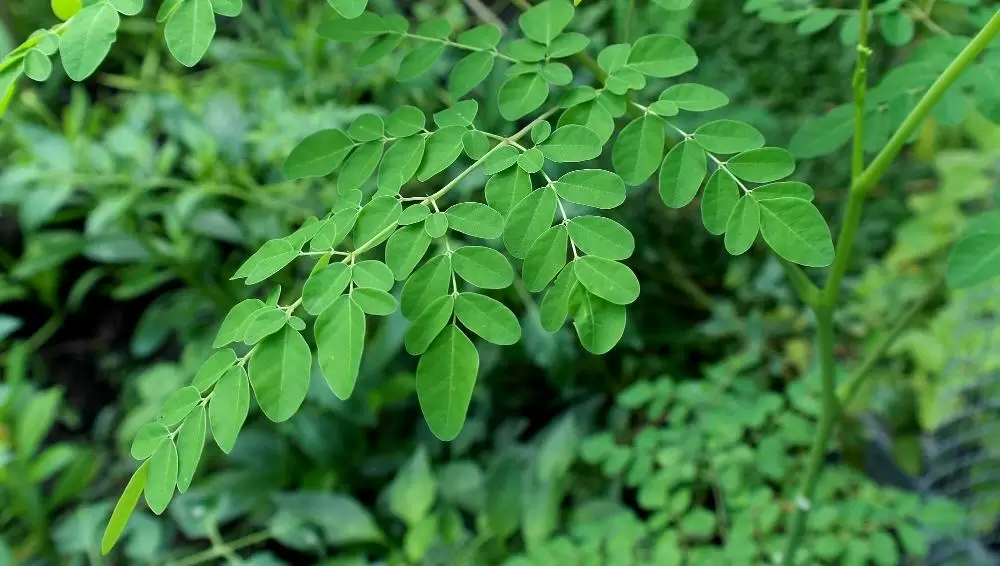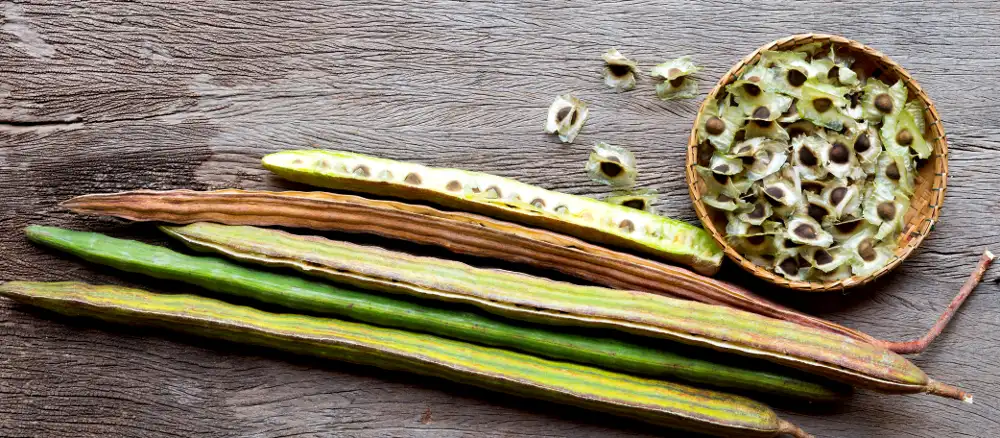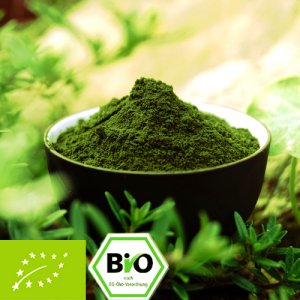Moringa Knowledge - All about Moringa Tea Powder - Application and Effect
Here you can find out everything about Moringa tea powder, from its cultivation and history to nutrients and recipes.
What is Moringa actually?

Young Moringa tree
Originally the Moringa tree comes from the Himalayas, but is now spread and known worldwide and is also called horseradish tree because of its pungent taste.
The moringas grow very fast and need very little water to grow. They grow up to six meters per year and produce up to 5000 seeds. The tree is also almost undemanding in terms of soil conditions.
What makes it special is that every part of the plant is suitable for human consumption.
Furthermore, the Moringa tree contains more nutrients than any other plant on earth.
In India Moringa has been used for over 5000 years. Moringa is already mentioned in the Vedas, the old Indian scriptures. It has special meaning here in Ayurvedic medicine. Ayurveda is the science of life and uses Moringa for more than 300 diseases. Examples are asthma, bacterial infections and diabetes. For Ayurveda the tree is the cure par excellence. There are now more than 700 studies that prove the many positive health effects of Moringa and to date no side effects are known.
Through trade relations Moringa became known and popular with the Romans about 2000 years ago.
In Jamaica an application for the cultivation of moringa was made in 1817 and shortly afterwards approved in the House of Representatives. Since then, the plant has also become indispensable here.
In the meantime Moringa is known almost worldwide and the whole of mankind can benefit from this special plant.
In Europe it is organic Moringa oleifera powder - 100% pure - premium qualitymainly sold in the form of powder.
Below you will find more exciting information that you should know about Moringa.
What is in Moringa oleifera?
First a short summary of the most important nutrients:
Vitamins:
The leaves of the wonder tree contain various vitamins.
These include on the one hand beta-carotene (vitamin A)which is responsible, among other things, for growth, the visual process, as well as for the structure of skin and mucous membranes. But this vitamin is also indispensable for the metabolism.
Vitamin C
Vitamin C is also water-soluble and takes over some tasks in the cardiovascular system. Also important: Vitamin C is responsible for calcium and iron absorption and strengthens the connective tissue.
vitamin E
Vitamin E has antioxidant properties and is also essential for skin and hair.
Vitamin K
Also this vitamin must not remain unmentioned. It can prevent vascular calcification and thus has a preventive effect.
Antioxidants:
Many different antioxidants have been found in Moringa leaves. But what are antioxidants? We hear this term almost daily or read it on various product packaging. However, very few people know what antioxidants actually are and what they do in our body.
Antioxidants prevent oxidative stress by intercepting free radicals that could otherwise damage the cells. In simple terms, this means that antioxidants protect the body's cells.
Omega-3 and Omega-6 fatty acids
These fatty acids are essential, which means that our body cannot synthesize them on its own and we therefore have to take them in with our food. They take over important tasks in our immune system and play an important role in the synthesis of hormones and proteins, among other things.
Essential amino acids
There are a total of eight essential amino acids, all of which could be found in the leaves of the Moringa tree. Amino acids are the building blocks for proteins and are therefore significantly involved in muscle building and indispensable for the human organism.
Minerals and trace elements
Numerous minerals and trace elements have been discovered in the Moringa plant, which perform various tasks in our body. These include magnesium and calcium, zinc, iron and many more!
Zeatin
Zeatin is a growth hormone which is responsible for the rapid growth of the tree. However, this hormone has other properties, which will be discussed later in the text.
This brief insight into the composition of the Moringa plant alone makes it clear how high the nutrient density must be and, associated with this, the health benefits that can be derived from this plant.
In our you will find many exciting recipe ideas.
Cultivation and harvest of Moringa:
The Moringa plant grows predominantly in subtropical and tropical countries on sandy soils and survives even dry weather periods without any problems due to the extraordinarily good storage function of the roots. However, it should be mentioned that, especially for the organic cultivation of the Moringa tree, mineral-rich soils are more suitable and have a positive effect on the plant's nutrient richness.
Humid climate and temperatures between 25 °C and 37 °C are optimal conditions for the plant. Frost, on the other hand, is just as intolerable as waterlogging, in which the roots and seeds rot and the tree ultimately dies. In order to prevent this waterlogging, the tree is often planted on a hill, or a slight elevation, or a kind of drainage channel is created next to the roots so that the water can drain away.
The Moringa tree is characterized by its thick trunk. Furthermore, the growth of the wonder tree is remarkable: Within one year, the tree can grow up to six meters high, depending on the growing area.

Moringa pods and seeds
In the long pods of the plant are the moringa seeds for propagation of the tree. These are placed about two centimetres deep in moist soil and covered with a little soil. After about one week the plant is twenty centimetres high and after three weeks it is already fifty centimetres high.
During this time, the smallest hair roots develop, which serve to strengthen the soil. Afterwards the upper part begins to form and spread. Both the tree crown and the roots need a lot of space, which is why the individual seedlings should not be planted too close to each other.
The plant should be protected from draughts during the first months of its growth. The leaves should also be protected from rain if possible because of their high sensitivity to water, otherwise they can turn yellow and rot. In the best case, the plant should be watered with water low in lime near the roots. It is important to make sure that the soil is permanently moist to create the best conditions for the development of the moringa tree.
The plant "lives" in the root and "feeds" on the leaves. Photosynthesis takes place in them and supplies the plant with everything it needs. Another special feature of moringa is that you can cut it back to the root and it will grow again. So you can harvest them completely and use all their components. Even the roots would be suitable for human consumption, but then the tree would die. The leaves of an adult tree can be harvested three to six times a year. After drying, which should not take place in full sun and always in a well ventilated, dry place, they are pulverized or chopped without stems. This product can then be used as a spice or tea. Moringa tea is a delight both hot and cold.
Health benefits of Moringa oleifera:
For several thousand years the Moringa tree has been used by humans for a wide variety of purposes. For example, the Indians saw its usefulness mainly for the brain, metabolism, bones and the nervous system, while for the shaman the analgesic effect for headaches as well as wound care was the main focus.
Even today, Moringa is still attributed great importance as a remedy in Ayurvedic medicine, as Ch. Murali Manohar, Doctor of Ayurveda, also points out in his book "Ayurveda for All".
A study carried out by French scientists proves that the roots of the Moringa tree have an anti-inflammatory effect. The magazine "Dakar med" has also already reported on the promising results of this study. Diseases such as rheumatoid arthritis or bronchitis should be able to be treated successfully with the extract of the Moringa roots. The scientists found out that the root extract has a similar effect to the also anti-inflammatory agent indomethacin, because both substances inhibited the edema within five hours.
The study is therefore very promising and gives an indication of the "healing" effect of the Moringa plant.
Zeatin - As mentioned above, zeatin is a growth hormone. But not only that is worth mentioning with regard to this hormone, great attention should also be paid to the cell regenerating effect, as this property of the so-called fountain of youth hormone can support and accelerate the regeneration of the skin cells, which is why Moringa is also said to have an anti-aging effect.
Culinary applications of Moringa:
Beyond the health benefits, the culinary use of the plant should also be increasingly considered.
But how is Moringa used in the kitchen?
Probably the best known use of Moringa leaves is Moringa tea. For this purpose, the leaves are dried, pulverised and chopped and then infused with water at a temperature of approx. 80 °C. After five to eight minutes of infusion, the hot drink is ready and tastes great with a teaspoon of tobacco blossom honey.
But Moringa is not only versatile as tea, but also as a spice.
A delicious Moringa soup with vegetarian dumplings is a tasty and meat-free alternative to the chicken soup so popular in autumn and winter and is at least as tasty and healthy.
In the Himalayas, the leaves are most often given fresh over salads or with vegetables, for which the young leaves are usually used.
As already mentioned, all parts of the plant can be consumed by humans. For example, the roots have a pungent taste very similar to horseradish.
The fruits of the moringas are processed and used as a kind of bean like vegetables.
From the seeds, in the past and today, oil is pressed, which can be used both for consumption and for the production of ointments, for example.
Did you know?
Did you know that the term "tea" is actually wrong? The Moringa leaves, and therefore also the powdered product made from them, do not contain teaine. Teein is the caffeine contained in tea. However, this is not contained in Moringa "tea", which is why the name is strictly speaking not correct. In colloquial language, however, we use the term tea to make it clear that it is a hot drink brewed with water.
Special features of the moringa seeds:
Most people are informed about the health benefits of eating the plant, but are unaware that the seeds of the moringa tree also have an incredibly positive benefit for people.
If crushed, they can bind pollutants from contaminated drinking water and kill the bacteria contained in it. This means that Moringa seeds provide us with a method of water treatment without complex filter systems, which would be of great importance especially in developing countries and could contribute to giving more people worldwide access to clean drinking water. Every day, around 5000 children die as a result of contaminated drinking water.
In the programme "The Great Show of Natural Wonders" the purifying effect of the moringa seeds was impressively presented by Ranga Yogeshwar, as can be seen in the following YouTube video.
If you put the seeds into the contaminated water, after not even two minutes two of a two-phase formation in the vessel will occur. This means that the bound pollutants sink to the bottom (phase 1) and the purified water (phase 2) can be skimmed off.
One can also filter the contaminated water through the seeds and collect the clean water in a separate vessel. Scientists studying the efficiency of this method have found that one seed is enough to purify one litre of water and rid it of 99% of harmful bacteria.
Moringa as a weapon in the fight against malnutrition:
But with Moringa not only the drinking water can be treated and thus an important contribution can be made in developing countries, but also the serious problem of malnutrition, especially of children, is tackled with the help of the miracle tree. The FOCUS reported in 2016 about a project called "OKI Moringa Children's Table©", initiated by Wiehl-hilft e. V.
25% of all children in the Congo die with less than five years of malnutrition and its consequences. The aim of this project is to reduce this number.
What does this have to do with Moringa? Very simple: Moringa is the most nutritious plant in the world, needs little water and grows fast. An optimal condition to tackle the famine in Congo.
With success! About 1500 children per year could be saved from their life-threatening condition. To prevent relapses, the mothers of the children receive some Moringa seeds and an introduction to growing and using them.
In 2008 Moringa was voted plant of the year by the National Institute of Health. This institution conducts research in the fields of biomedicine and human health. The research results are intended to help develop products that maintain and promote human health.
It should now have become clear how important Moringa oleifera is due to its high nutrient density and incredible versatility, and this for all people worldwide. On our homepage under the category Recipes you will find various recipe ideas around Moringa oleifera and many more of our products!

.jpg)